Xinchen Luo
OneRec-V2 Technical Report
Aug 28, 2025Abstract:Recent breakthroughs in generative AI have transformed recommender systems through end-to-end generation. OneRec reformulates recommendation as an autoregressive generation task, achieving high Model FLOPs Utilization. While OneRec-V1 has shown significant empirical success in real-world deployment, two critical challenges hinder its scalability and performance: (1) inefficient computational allocation where 97.66% of resources are consumed by sequence encoding rather than generation, and (2) limitations in reinforcement learning relying solely on reward models. To address these challenges, we propose OneRec-V2, featuring: (1) Lazy Decoder-Only Architecture: Eliminates encoder bottlenecks, reducing total computation by 94% and training resources by 90%, enabling successful scaling to 8B parameters. (2) Preference Alignment with Real-World User Interactions: Incorporates Duration-Aware Reward Shaping and Adaptive Ratio Clipping to better align with user preferences using real-world feedback. Extensive A/B tests on Kuaishou demonstrate OneRec-V2's effectiveness, improving App Stay Time by 0.467%/0.741% while balancing multi-objective recommendations. This work advances generative recommendation scalability and alignment with real-world feedback, representing a step forward in the development of end-to-end recommender systems.
Kwai Keye-VL Technical Report
Jul 02, 2025Abstract:While Multimodal Large Language Models (MLLMs) demonstrate remarkable capabilities on static images, they often fall short in comprehending dynamic, information-dense short-form videos, a dominant medium in today's digital landscape. To bridge this gap, we introduce \textbf{Kwai Keye-VL}, an 8-billion-parameter multimodal foundation model engineered for leading-edge performance in short-video understanding while maintaining robust general-purpose vision-language abilities. The development of Keye-VL rests on two core pillars: a massive, high-quality dataset exceeding 600 billion tokens with a strong emphasis on video, and an innovative training recipe. This recipe features a four-stage pre-training process for solid vision-language alignment, followed by a meticulous two-phase post-training process. The first post-training stage enhances foundational capabilities like instruction following, while the second phase focuses on stimulating advanced reasoning. In this second phase, a key innovation is our five-mode ``cold-start'' data mixture, which includes ``thinking'', ``non-thinking'', ``auto-think'', ``think with image'', and high-quality video data. This mixture teaches the model to decide when and how to reason. Subsequent reinforcement learning (RL) and alignment steps further enhance these reasoning capabilities and correct abnormal model behaviors, such as repetitive outputs. To validate our approach, we conduct extensive evaluations, showing that Keye-VL achieves state-of-the-art results on public video benchmarks and remains highly competitive on general image-based tasks (Figure 1). Furthermore, we develop and release the \textbf{KC-MMBench}, a new benchmark tailored for real-world short-video scenarios, where Keye-VL shows a significant advantage.
OneRec Technical Report
Jun 16, 2025Abstract:Recommender systems have been widely used in various large-scale user-oriented platforms for many years. However, compared to the rapid developments in the AI community, recommendation systems have not achieved a breakthrough in recent years. For instance, they still rely on a multi-stage cascaded architecture rather than an end-to-end approach, leading to computational fragmentation and optimization inconsistencies, and hindering the effective application of key breakthrough technologies from the AI community in recommendation scenarios. To address these issues, we propose OneRec, which reshapes the recommendation system through an end-to-end generative approach and achieves promising results. Firstly, we have enhanced the computational FLOPs of the current recommendation model by 10 $\times$ and have identified the scaling laws for recommendations within certain boundaries. Secondly, reinforcement learning techniques, previously difficult to apply for optimizing recommendations, show significant potential in this framework. Lastly, through infrastructure optimizations, we have achieved 23.7% and 28.8% Model FLOPs Utilization (MFU) on flagship GPUs during training and inference, respectively, aligning closely with the LLM community. This architecture significantly reduces communication and storage overhead, resulting in operating expense that is only 10.6% of traditional recommendation pipelines. Deployed in Kuaishou/Kuaishou Lite APP, it handles 25% of total queries per second, enhancing overall App Stay Time by 0.54% and 1.24%, respectively. Additionally, we have observed significant increases in metrics such as 7-day Lifetime, which is a crucial indicator of recommendation experience. We also provide practical lessons and insights derived from developing, optimizing, and maintaining a production-scale recommendation system with significant real-world impact.
Short Video Segment-level User Dynamic Interests Modeling in Personalized Recommendation
Apr 05, 2025



Abstract:The rapid growth of short videos has necessitated effective recommender systems to match users with content tailored to their evolving preferences. Current video recommendation models primarily treat each video as a whole, overlooking the dynamic nature of user preferences with specific video segments. In contrast, our research focuses on segment-level user interest modeling, which is crucial for understanding how users' preferences evolve during video browsing. To capture users' dynamic segment interests, we propose an innovative model that integrates a hybrid representation module, a multi-modal user-video encoder, and a segment interest decoder. Our model addresses the challenges of capturing dynamic interest patterns, missing segment-level labels, and fusing different modalities, achieving precise segment-level interest prediction. We present two downstream tasks to evaluate the effectiveness of our segment interest modeling approach: video-skip prediction and short video recommendation. Our experiments on real-world short video datasets with diverse modalities show promising results on both tasks. It demonstrates that segment-level interest modeling brings a deep understanding of user engagement and enhances video recommendations. We also release a unique dataset that includes segment-level video data and diverse user behaviors, enabling further research in segment-level interest modeling. This work pioneers a novel perspective on understanding user segment-level preference, offering the potential for more personalized and engaging short video experiences.
QARM: Quantitative Alignment Multi-Modal Recommendation at Kuaishou
Nov 18, 2024



Abstract:In recent years, with the significant evolution of multi-modal large models, many recommender researchers realized the potential of multi-modal information for user interest modeling. In industry, a wide-used modeling architecture is a cascading paradigm: (1) first pre-training a multi-modal model to provide omnipotent representations for downstream services; (2) The downstream recommendation model takes the multi-modal representation as additional input to fit real user-item behaviours. Although such paradigm achieves remarkable improvements, however, there still exist two problems that limit model performance: (1) Representation Unmatching: The pre-trained multi-modal model is always supervised by the classic NLP/CV tasks, while the recommendation models are supervised by real user-item interaction. As a result, the two fundamentally different tasks' goals were relatively separate, and there was a lack of consistent objective on their representations; (2) Representation Unlearning: The generated multi-modal representations are always stored in cache store and serve as extra fixed input of recommendation model, thus could not be updated by recommendation model gradient, further unfriendly for downstream training. Inspired by the two difficulties challenges in downstream tasks usage, we introduce a quantitative multi-modal framework to customize the specialized and trainable multi-modal information for different downstream models.
ELASTIC: Efficient Linear Attention for Sequential Interest Compression
Aug 20, 2024



Abstract:State-of-the-art sequential recommendation models heavily rely on transformer's attention mechanism. However, the quadratic computational and memory complexities of self attention have limited its scalability for modeling users' long range behaviour sequences. To address this problem, we propose ELASTIC, an Efficient Linear Attention for SequenTial Interest Compression, requiring only linear time complexity and decoupling model capacity from computational cost. Specifically, ELASTIC introduces a fixed length interest experts with linear dispatcher attention mechanism which compresses the long-term behaviour sequences to a significantly more compact representation which reduces up to 90% GPU memory usage with x2.7 inference speed up. The proposed linear dispatcher attention mechanism significantly reduces the quadratic complexity and makes the model feasible for adequately modeling extremely long sequences. Moreover, in order to retain the capacity for modeling various user interests, ELASTIC initializes a vast learnable interest memory bank and sparsely retrieves compressed user's interests from the memory with a negligible computational overhead. The proposed interest memory retrieval technique significantly expands the cardinality of available interest space while keeping the same computational cost, thereby striking a trade-off between recommendation accuracy and efficiency. To validate the effectiveness of our proposed ELASTIC, we conduct extensive experiments on various public datasets and compare it with several strong sequential recommenders. Experimental results demonstrate that ELASTIC consistently outperforms baselines by a significant margin and also highlight the computational efficiency of ELASTIC when modeling long sequences. We will make our implementation code publicly available.
Chinese Tiny LLM: Pretraining a Chinese-Centric Large Language Model
Apr 09, 2024



Abstract:In this study, we introduce CT-LLM, a 2B large language model (LLM) that illustrates a pivotal shift towards prioritizing the Chinese language in developing LLMs. Uniquely initiated from scratch, CT-LLM diverges from the conventional methodology by primarily incorporating Chinese textual data, utilizing an extensive corpus of 1,200 billion tokens, including 800 billion Chinese tokens, 300 billion English tokens, and 100 billion code tokens. This strategic composition facilitates the model's exceptional proficiency in understanding and processing Chinese, a capability further enhanced through alignment techniques. Demonstrating remarkable performance on the CHC-Bench, CT-LLM excels in Chinese language tasks, and showcases its adeptness in English through SFT. This research challenges the prevailing paradigm of training LLMs predominantly on English corpora and then adapting them to other languages, broadening the horizons for LLM training methodologies. By open-sourcing the full process of training a Chinese LLM, including a detailed data processing procedure with the obtained Massive Appropriate Pretraining Chinese Corpus (MAP-CC), a well-chosen multidisciplinary Chinese Hard Case Benchmark (CHC-Bench), and the 2B-size Chinese Tiny LLM (CT-LLM), we aim to foster further exploration and innovation in both academia and industry, paving the way for more inclusive and versatile language models.
CAN: Revisiting Feature Co-Action for Click-Through Rate Prediction
Nov 11, 2020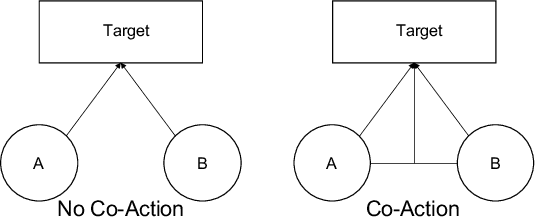

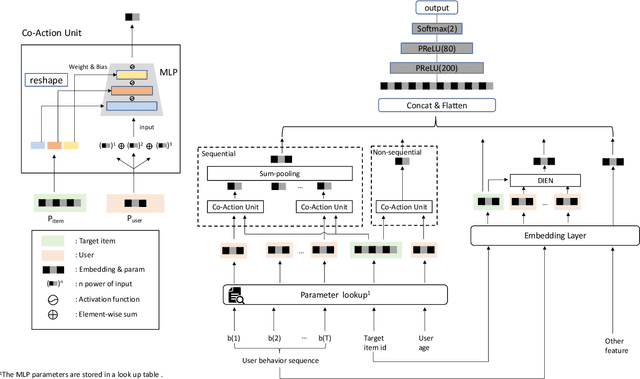
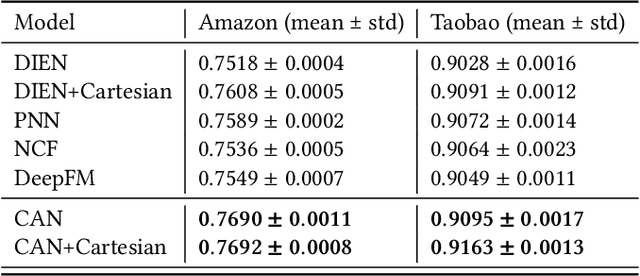
Abstract:Inspired by the success of deep learning, recent industrial Click-Through Rate (CTR) prediction models have made the transition from traditional shallow approaches to deep approaches. Deep Neural Networks (DNNs) are known for its ability to learn non-linear interactions from raw feature automatically, however, the non-linear feature interaction is learned in an implicit manner. The non-linear interaction may be hard to capture and explicitly model the \textit{co-action} of raw feature is beneficial for CTR prediction. \textit{Co-action} refers to the collective effects of features toward final prediction. In this paper, we argue that current CTR models do not fully explore the potential of feature co-action. We conduct experiments and show that the effect of feature co-action is underestimated seriously. Motivated by our observation, we propose feature Co-Action Network (CAN) to explore the potential of feature co-action. The proposed model can efficiently and effectively capture the feature co-action, which improves the model performance while reduce the storage and computation consumption. Experiment results on public and industrial datasets show that CAN outperforms state-of-the-art CTR models by a large margin. Up to now, CAN has been deployed in the Alibaba display advertisement system, obtaining averaging 12\% improvement on CTR and 8\% on RPM.
DCAF: A Dynamic Computation Allocation Framework for Online Serving System
Jun 17, 2020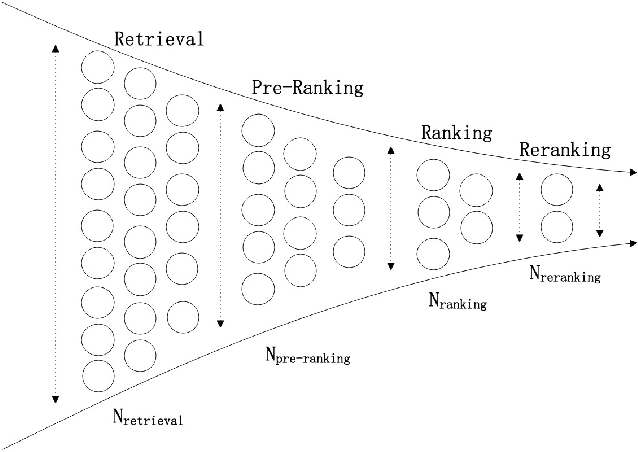
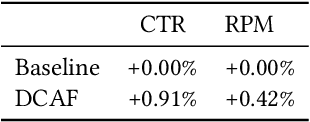
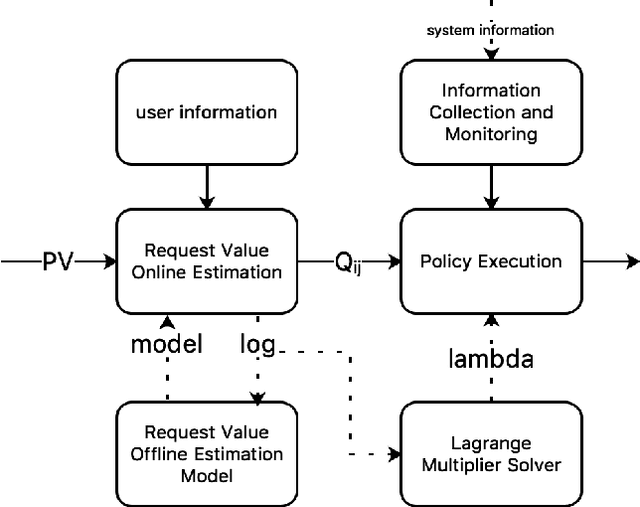

Abstract:Modern large-scale systems such as recommender system and online advertising system are built upon computation-intensive infrastructure. The typical objective in these applications is to maximize the total revenue, e.g. GMV~(Gross Merchandise Volume), under a limited computation resource. Usually, the online serving system follows a multi-stage cascade architecture, which consists of several stages including retrieval, pre-ranking, ranking, etc. These stages usually allocate resource manually with specific computing power budgets, which requires the serving configuration to adapt accordingly. As a result, the existing system easily falls into suboptimal solutions with respect to maximizing the total revenue. The limitation is due to the face that, although the value of traffic requests vary greatly, online serving system still spends equal computing power among them. In this paper, we introduce a novel idea that online serving system could treat each traffic request differently and allocate "personalized" computation resource based on its value. We formulate this resource allocation problem as a knapsack problem and propose a Dynamic Computation Allocation Framework~(DCAF). Under some general assumptions, DCAF can theoretically guarantee that the system can maximize the total revenue within given computation budget. DCAF brings significant improvement and has been deployed in the display advertising system of Taobao for serving the main traffic. With DCAF, we are able to maintain the same business performance with 20\% computation resource reduction.
 Add to Chrome
Add to Chrome Add to Firefox
Add to Firefox Add to Edge
Add to Edge